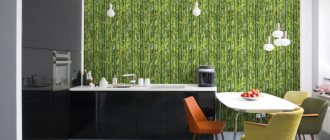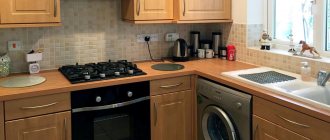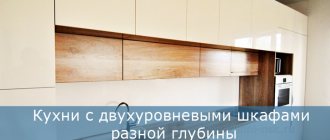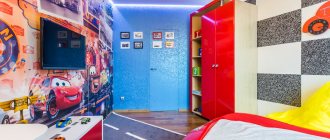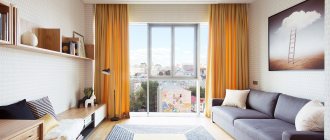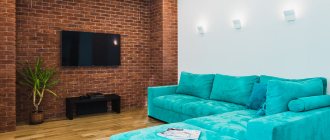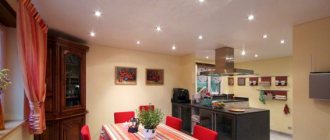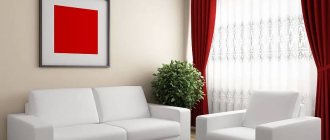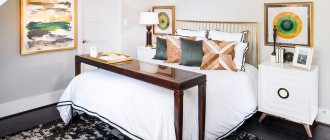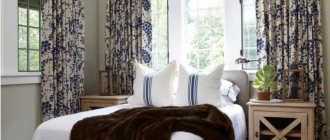/Accessories and decor/Decoration/
Kitchen wall decor is all about making it cozy, vibrant and personalized. In addition, some wall decoration techniques can help out if you need to zone a space, correct some shortcomings in the room or mistakes in the interior, say, curtains and an apron that do not match in color. In this material we will tell you how you can decorate your kitchen walls, how to do it correctly and what wall accessories you should make yourself.
What materials are used to decorate the walls?
Any kitchen is divided into several functional areas. It is worthwhile to touch upon the theme of the design of each of them, as well as familiarize yourself with design techniques, interesting solutions, and suitable materials.
Every owner, unless he has a designer working for him, is sure to face the problem of choosing finishing materials. Indeed, there are a lot of options, but it’s even more difficult to combine them. In short, for finishing the following can be used:
- Ceramic tile;
- Mosaic;
- Coloring;
- Decorative plaster;
- Wallpaper;
- Artificial and natural stone;
- Regular and decorative bricks;
- MDF, PVC panels;
- Natural wooden lining;
- Plastic lining;
- 3D tiles.
The choice of colors is primarily a matter of individual perception. However, it is worth familiarizing yourself with the opinions of psychologists about the influence of color on a person and his mood before making a final decision.
Plastic panels
PVC panels are not as useful a material as their wooden relatives, but they are also often found in kitchen decoration.
They are characterized by ease of installation, many shades and patterns. The panels can perfectly imitate wood, marble, and stone.
They are not afraid of temperature changes and moisture. They are not subject to rot and mold.
Caring for them is completely simple, they do not attract dirt and are easy to clean with plain water. They are not afraid of chemicals either.
Inexpensive cost will be another advantage of this finish.
However, they are not very durable and environmentally friendly; they can fade when exposed to strong ultraviolet rays.
Apron design
A kitchen apron is not only clothes with colored ties and gastronomic patterns. This is also an important part of the kitchen - the wall between the countertop and the upper cabinets. Even 20 years ago, no one thought that it could somehow be highlighted in the overall interior; why is this even necessary? Modern aprons are so varied in design that it can be difficult to make a choice.
What should your kitchen apron be like: a bright accent or an unsightly work surface? It will complement the marble countertop or create a contrast with the finishing material. The apron should be expensive and presentable, or you can save money on this detail. Having answered these questions, you can already roughly get your bearings. You can finally decide what it will be like by reading all the possible options and looking at photos on the Internet.
To construct a working wall, you can use the following materials:
- Ceramic tiles;
- Natural or artificial stone;
- Brick;
- Tempered glass;
- Mosaic;
- Metal;
- PVC, MDF panels;
- Plastic lining (can be used for budget repairs).
Dye
The most ancient version of kitchen design will help to decorate the room in a familiar or unusual way.
Dye:
- Feels great in any climate change;
- Retains its attractiveness for a long time;
- Does not require hassle or worries.
If desired, a flat surface can be decorated with patterns or stickers, creating the most unique design. The material is perfect for any design style and any area.
Wall decoration near the dining table
It is advisable to separate the dining area from the working area without disturbing the overall style. Use materials that do not get dirty or are easy to clean. Although, if desired, the finishing can be any: decorative plaster, textiles, brick, vinyl, washable and photo wallpaper, wooden lining, mirror tiles, painted surface. It is interesting to separate the dining area by decorating the wall with the approach to the ceiling. The color may be darker or lighter than the main tone specified in the interior. Less often, the zone is made an accent, a completely different compatible color is chosen.
A mandatory attribute of the wall in a mini-dining room is decor. There are many options here: painting, poster, photographs, decorative plates, mirror, wall clock, sconces, wooden cutting boards, decorative trays, slate or cork message board, decorative stickers, empty frames.
How to decorate a corner of a wall?
For decoration, small shelves are used, on which it will be convenient to place photographs, dishes, figurines or boxes. Mirrors or paintings will also be appropriate, which will fit perfectly into the corner space and make the interior brighter and more comfortable. Flowers in original pots and cache-pots will also be a wonderful addition and decoration to the corner.
Decorative brick in the interior
Embossed brick-shaped wallpaper was once very popular. Fortunately, those times and materials have long been forgotten; they have been replaced by new decorative solutions. Decorative bricks are usually used for interior decoration. It is much thinner and lighter than facing. There are different types and colors. Some manufacturers' lines contain artificially aged material. In order for brickwork to look organic, it is worth knowing in which interiors it can be used and in what form.
Decorative brick goes well with wood and glass. It looks good against the background of plastered walls. The masonry can be seen in the area of the working wall or dining area. The arched entrance to the kitchen in the form of a brick vault looks original. Imitation of masonry is widely used in loft, country, high-tech, and English styles. Fresh flowers harmoniously complement the brick wall.
Brick in the interior should be used in reasonable quantities, only then will it look stylish and emphasize the individuality of the decor, and not make it look like an old basement.
Choosing wall color for the kitchen
As for the color of the walls, its choice should depend on several factors: the size of the room, the chosen interior style, the location of the windows (south or north side), and the preferences of the home owners.
Currently, there are no strict restrictions on color; any shades can be used in wall decoration - the main thing is to take into account all available factors. For example, if the kitchen is small, then it is better to make the walls as light as possible, then the room will look more spacious.
In the kitchen, whose windows face the cold server side, you can paint the walls in warm, soft colors - beige, light yellow, pale pink.
In addition, the color of the walls should be in harmony with the style of the interior - for example, white tones are perfect for creating a kitchen in the Provence, Mediterranean, Scandinavian, or shabby chic styles. Bright colors go with modern styles, while soft and muted colors go with classic ones.
Decorative plaster
Modern decorative plaster can be perfectly smooth or rough; it allows you to create a surface that imitates fabric, paper, suede, metal, wood, stone, leather. Can be painted in any color. Other original options include decorative concrete art and a coating with a craquelure effect. “Venetian” looks very beautiful in the kitchen. The calling card of the coating is a smooth surface that shimmers in the light with a pearly sheen. Modern mixtures contain antiseptic and fungicidal elements, and therefore prevent the formation of mold in the kitchen.
Advice! Before decorating the kitchen walls with decorative plaster, it is advisable to see how it looks in person, and not in the photo.
Textured plaster is rarely used on all walls. Usually it highlights one wall or dining area. You can decorate the working wall with decorative plaster and cover it with transparent glass on top. In addition, it is customary to supplement plaster with other decorative elements: artificial stone, decorative brick. The most suitable solution would be in the style of minimalism, loft, shabby chic, country.
It is impossible to say which decorative plaster for the kitchen will be better. It all depends on the interior and personal preferences. Those who are going to do cosmetics should take into account that it is very difficult to remove. It is literally cut from the wall with a grinder and a hammer drill. And it’s almost impossible to apply it beautifully without experience.
Accents in decorating walls with wallpaper
The main wall should immediately catch the eye, so it is important to use photo wallpaper.
The theme should be neutral and appropriate for the area where food is prepared and consumed.
The second function of photo wallpaper is to visually expand the size of the kitchen and optical illusion in the form of raising the ceiling.
It is best to place them in the dining area.
If you have a low ceiling, it is recommended to buy photo wallpaper with an elongated geometric pattern.
The presence of diamonds and vertical stripes in them will visually add height to the room.
Narrow openings will be made more spacious by a covering with horizontal lines. A dark kitchen will be enlivened by wallpaper in golden, peach or orange.
A striking example is a classic kitchen with a wall decorated with wall sconces and a painting.
Attention! If the room does not need to create additional “special effects,” then it is better to opt for any wall covering you like.
Painting walls
The painted surface can be used in almost any style of kitchen. Preference should be given to washable paints, for example, latex or silicone. After drying, a film forms on them, which protects them from moisture and abrasion. It is important that the surface is well prepared before painting. The final result depends on how smooth it is.
Paints come in matte, glossy, plain, and gradient. Using paint and a stencil, you can create the most incredible designs on the wall. You can use paint to highlight the lower part of the wall at 2/3 of the floor, and also paint the entire surface up to the ceiling.
Advice! The mainstream of modern kitchens is the use of graphite paint on one wall. The surface becomes a kind of blackboard on which you can write notes, hang photographs, and draw.
Types of finishing
Each material has advantages and disadvantages that you need to know before making a choice.
Ceramic tile
Tiles are widely used for finishing kitchens - in old-style renovations it is difficult to find an apartment where a different material was used. This is due to specific advantages:
- Moisture resistant. For the same reason, tiles are chosen for finishing bathrooms. It is absolutely insensitive to moisture if installed according to the standard, so that the seams remain sealed.
- Resistant to temperature changes. The tiles do not crack from high heat and do not burn. Doesn't crumble due to frost. Because of this feature, it is often used in exterior decoration.
Pure wood should not be used in the kitchen
- Easy to care for. The tiles are most often covered with enamel - you can simply wipe off fresh dirt from it with a wet cloth. And if the dirt has already dried, even aggressive chemicals will not affect the appearance of the tiles.
- Diversity. Tiles are a beautiful material that comes in different shapes, different colors, and different patterns. It opens up space for imagination; with its help you can lay out intricate patterns, making your kitchen unique.
- Durability. With proper use, tiles can last for decades, even if lying on the floor. And on walls, where even special abrasion resistance is not needed, it wears out very slowly.
Use tiles in decoration, they are easy to clean
It has no downsides, except for one thing - the elegant enamel can be scratched.
Interestingly, in recent years, new types of tiles have entered the market that can be brilliantly used in kitchen design:
- three-dimensional ceramic tiles have convex and concave sides, from which you can create not a simple two-dimensional pattern, but a three-dimensional pattern;
- Liquid tiles are made to change color when pressed - it looks beautiful on the floor, but it will also look fresh on the wall, and children will especially like it.
Green tiles in decoration
When purchasing you need to consider:
- type of tile - in the first defect there will be less than five percent, but in the second there will be about twenty;
- general condition - there should be no cracks, depressions, yellow spots on either the outer or inner side of the tile;
- resistance to detergents - the “AA” marking means that you can use any compounds you like, but it is better to handle class “A” tiles with care.
Tiles are a beautiful material that comes in different forms.
The thickness of the wall tiles does not exceed four millimeters. It is specially marked with a palm icon - this means that it was made specifically for walls.
Tip Tiles can be matte, glossy or mirrored. You need to understand what you want your kitchen to look like and choose based on that.
Mosaic
Mosaic is made from different materials, its advantages are similar to those of tiles. It is also insensitive to moisture and temperatures, can also last for decades, is available in different colors, shapes, and is easy to care for. The standout plus is aesthetics.
With tiles you cannot achieve the same level as with mosaics. You can lay out drawings, complex panels, and highly detailed patterns.
Mosaic in the kitchen interior
But mosaics also cost significantly more than regular tiles.
You can lay out drawings, complex panels, patterns with high detail
Advice In order for the mosaic to reveal itself to its full potential, it is better not to lay it yourself, but to hire a master. It will be more expensive, but the result cannot be repeated at home.
Dye
Kitchen paint is used with reservations - nevertheless, its durability is less than that of tiles, especially natural stone.
There are several advantages:
- Easy to apply. The tile can be laid crookedly, a mosaic will require a master, but any paint can be applied by a person who has never held a brush in his hands, especially if he practices a little first.
- Diversity. The paint can be matte, glossy, different colors, different shades. Moreover, this is the most classic material for creating drawings - you can not only apply a simple geometric pattern with it, which anyone can do, but even copy a classic painting if you have the patience.
The paint is easy to apply
- Easily repaired. If the paint peels or cracks, simply add another layer on top and the original appearance will be restored.
- Moisture resistance. Paint is often used to cover walls in swimming pools and bathrooms - and all because it is insensitive to moisture.
- Easy to care for. Painted walls are wiped with a cloth, either wet or dry. However, it is not recommended to use aggressive chemicals.
- Resistance to biological threats. Does not rot, cannot become infected with fungus.
Painted walls are wiped with a cloth, either wet or dry.
But there are also disadvantages:
- The need for good preparation. Walls for painting must be perfectly smooth, otherwise all cracks, depressions, and other defects will be clearly visible.
- Possible instability. Not all paints remove stains easily, so before painting a wall in your work area, you should carefully read the specifications.
Of course, there is more than one type of paint. For painting in the kitchen you can use:
- water-based paint - non-toxic, dries quickly, odorless;
- acrylic - durable, odorless, suitable for painting, since multi-colored colors are common;
- alkyd paints are cheap, hold up well, but have a strong smell when dry.
Using subdued tones
It is interesting that in recent years new types of paint have appeared that have not yet come into widespread use:
- slate and marker paints allow you to draw on a dry surface either with chalk or special markers;
- antibacterial paints contain silver ions, killing pathogenic bacteria, which is important for the kitchen;
- Magnetic paints contain tiny iron particles, so that after drying, magnets can be attached to walls anywhere.
Advice A painted kitchen does not look very aesthetically pleasing - unless, of course, you put effort into patterns and designs - so a good solution would be to combine paint with other materials.
Wallpaper
The idea that wallpaper is not suitable for the kitchen has long been refuted, because in addition to paper, other varieties that are more resistant to environmental influences have long appeared. Each of them has its own advantages.
Wallpaper with inscriptions in the interior of the room
- Vinyl wallpapers . The bottom layer is paper, the top is synthetic. Durable, reliable, do not fade from the sun, do not suffer from wet cleaning, and can decorate the kitchen for decades. At the same time, they are absolutely airtight, which is why fungus can grow on them without daily airing of the kitchen. The first few days will have a specific smell, but over time the smell will dissipate.
- Silkscreen printing. Essentially a type of vinyl, but interspersed with silk threads. The pros and cons are the same, but what stands out is the appearance: with this wallpaper it will seem like the walls are covered with a thin patterned fabric. The wall underneath them should be perfectly flat.
- Glass wallpaper . They are made of glass threads, strong, durable, moisture-permeable, and can be painted. But they are expensive, and besides, they are difficult to dismantle - in order to change the material if you get tired of it, you will have to tinker.
- Liquid wallpaper . They do not need to be glued, just dilute the mixture and apply it to the wall like plaster. Reliable, provide additional sound and thermal insulation, washable, and mask minor wall defects.
But expensive ones require the use of special varnishes after application, otherwise they will wear out.
Bright, sunny color in the interior
- Non-woven wallpaper . The advantages are standard - durability, strength, resistance to temperature and humidity. The only unique thing is the ability to choose a texture to your taste and apply any paint to it, and good wallpaper can survive staining up to ten times. There is one minus - dust accumulates in the complex texture of the wallpaper, so they need to be cleaned regularly.
- Impregnated paper wallpaper . Cheap material that will become unusable in two to three years. It absorbs odors, fades in the sun, and stains are difficult to remove. But if you need to make repairs in conditions of total savings, this is the solution.
There are wallpapers that have recently appeared on the market: so-called live wallpapers, the pattern on which changes depending on the temperature. The simplest example is when the temperature rises, flowers bloom on the green branches covering the wallpaper.
Wallpaper goes well with tiles
These need to be placed either in the area of the stove or above the battery to allow for changes. But in general, the kitchen is a place where the temperature changes constantly and live wallpaper can reveal its full potential.
Tip Wallpaper also goes well with tiles, but you can also cover your work area with it.
What kind of wallpaper should I use?
Wallpaper is not usually used on the work surface; it will be an excellent solution for the rest of the room. For the kitchen, it is customary to choose washable vinyl, non-woven or glass wallpaper. Many of them can be painted and can withstand 6-7 updates. One of the popular types of vinyl wallpaper is silk-screen printing. The design has a pleasant silky shine and does not fade in the sun for a long time. Using fiberglass wallpaper you can create a beautiful texture or a perfectly smooth surface.
Luxurious textile wallpaper with embossing will perfectly complement the wood. Silvery shades will be reflected in the surface of household appliances or cladding. As for designs, the most popular are plant and floral patterns. They refresh traditional furnishings and add personality. Wallpaper can be an inconspicuous addition to the interior or a key accent.
Photo wallpapers were once in every apartment and apparently became so boring that today little attention is paid to them. In addition, the price of such finishing is a bit steep. In defense of modern photographic printing, it is worth saying that panoramic images look great in a small room; they decorate and visually enlarge the space, acting as a “window”.
Wallpaper can be combined if they belong to the same segment and differ only in color and pattern. For these purposes, manufacturers produce lines of companion models. Most often, floral patterns are complemented with stripes. The wallpaper may not match the color of the facade, but must certainly be in harmony with it. Bright, with an unusual pattern, they will dilute the monochrome atmosphere. The patchwork technique looks very unusual. It is one of the most difficult to perform, but the result is impressive. The wall decoration becomes like a patchwork quilt.
Photo wallpaper for a small kitchen
Photo wallpapers have long been out of all design solutions. BUT they have one advantage - if you choose the right design and perspective - they perfectly visually expand the space in small kitchens. We recommend reading our article about photo wallpapers that expand space and what they should be like
Interior with tiles
Tile is most often used in the work area. This is an excellent solution for covering an apron. On kitchen walls, tiles are used carefully so as not to turn the room into something like a bathroom. For this reason, the material is very rarely used for cladding free walls, but is still present in some designs. Tiles must correspond to modern design; ceramic tiles often fade into the background, giving way to porcelain tiles and glass.
For kitchen walls, tiles that imitate wood or 3D with an interesting three-dimensional texture are more suitable. The dimensions of the tiles must correspond to the area of the room. In small rooms, huge tiles do not look very good, but in large kitchens, on the contrary, small ones will not be the best choice.
Using tiles, they create an imitation of brickwork or wooden lining. A tile panel can become a real decoration of the kitchen. Patchwork style cladding looks very interesting in rustic interiors.
Wooden panels
You can create a beautiful, environmentally friendly, cozy room if you use wooden lining. The decoration is perfect for spacious rooms, making you remember a carefree childhood and an old house with the aroma of the stove and pies.
The tree is not afraid of temperature changes and is not afraid of room humidity. Especially if you pre-treat the wood with varnish or other protective agents.
Such panels are distinguished by their durability and soft texture, they are pleasant to the touch and maintain a pleasant temperature regardless of the environment.
They perfectly create a surprisingly fresh aroma of a summer forest, allow air to pass through perfectly, and regulate humidity.
Wooden panels are good sound insulators.
Pine and cedar boards can destroy pathogens, purify the air and help improve immunity.
Disadvantages include the difficulty of removing stains and the expensive cost of the material.
Mirror tiles in interior design
Modern mirror surfaces are made on the basis of acrylic, glass and polystyrene, which is also called mirror plastic. The role of a mirror in a room is enormous. It visually enlarges the space, enhances lighting, decorates and complements the interior. There are many materials with a mirror surface, and there are even more ways to use them in kitchen design.
Sheet panels are most often used to decorate furniture facades or kitchen splashbacks. By the way, a mirror apron is an original thing, but not very popular. Apart from its unusual appearance and visual enlargement of the kitchen, it has no other advantages. The disadvantage is low practicality, such an apron is easy to damage, it will be difficult to keep clean, it looks terrible when fogged up, and the amount of dirty dishes at least doubles. The same cannot be said about the mirror surface at the bar counter; here it will come in handy.
The kitchen interior uses mirror mosaics, tiles of different sizes and shapes. In addition, the mirror can be regular, colored, matted, chrome-plated, aged, with an amalgam pattern or a sandblasted image.
Important! Use mirrors in the interior with caution. Some people find it difficult to be in a room with a large reflective surface.
Tips for correcting walls and ceilings without major repairs
Leveling walls and reconstructing them is not a cheap pleasure. Without major repairs, it is possible to disguise existing shortcomings using simple methods.
- Shelf construction. In the future, it will serve as a showcase to divert attention from the worn-out elements of the kitchen interior. Placing a beautiful set of dishes on it is an excellent solution to the existing problem. An outside observer will be interested in the elegant service and will not notice the unevenness of the wall.
Open shelves are not only decorative, but also a practical element of the interior. You can place colorful jars of spices, glasses, and cups on them.
- Using vinyl stickers. Old wallpaper will sparkle with new colors when using new pictures. They are easy to replace in the future because vinyl stickers can be easily removed. Ceiling defects can also be masked in this way.
Thanks to the huge variety of options for stickers with designs, for example in the form of animals, birds, butterflies, flowers or trees, it is possible to create a unique atmosphere in the kitchen.
- Decor to the maximum. In this case, it is best to take advice from a designer. Some partitions in the room cannot be straightened and restructured in a hurry. Life in aesthetic comfort will not be suspended if the existing gaps are compensated by appropriately used interior items.
The first thing you should pay attention to is the design of the wall near the dining table.
- Buying sockets for the ceiling. They are usually made from polystyrene foam, which is not an expensive material. They can also be used to decorate walls that require repair. If desired, the sockets can be painted in any shade you like.
The disadvantage of such an acquisition is the undesirable proximity of polystyrene foam to the stove and dining area due to damage to the original material.
Wall panels, PVC and MDF panels
A wall panel does not have to be a masterpiece. This is just a decorative spot to add the finishing touch. It can be of any shape, size, and made from a wide variety of materials. The role of panels in the kitchen is fabric appliqué, embroidery, graphic images, wooden, ceramic, mosaic paintings, metal sculpture, plaster or textured plaster stucco, 3D panels. The panel can be permanent, when, for example, gypsum panels are mounted on the wall, or removable.
The main thing to take into account is that the kitchen is a functional space; particles of grease settle on surfaces, so decorative elements should be easy to clean or thrown away after contamination. Place the decor in the place that you want to visually highlight. This could be an apron, a dining area, or a wall near the bar. The main thing to take into account is that the kitchen is a functional space; grease particles settle on the walls, so the panel elements should be easy to clean or thrown away once dirty. Place the decor in the place that you want to visually highlight. This could be an apron, a dining area, or a wall near the bar.
The panel does not have to be flat or abstract. It can be a three-dimensional picture made from materials that are found every day in life, but it is better if they are kitchen-themed: plates, cups, pasta or a herbarium on burlap in a frame. It could be decoupage on eggshells, a letter made from wine corks, a picture made from wood.
It is impossible not to mention PVC or MDF panels, which have recently been increasingly used to decorate kitchen walls. In appearance and installation method, they resemble plastic lining, but are more durable. The appearance qualitatively imitates wood. An excellent option for those who want a wooden kitchen, but are not able to afford solid wood paneling. The panels can cover the wall up to the ceiling or only 2/3 of the height. They can be mounted both horizontally and vertically.
Jack of all trades
Sooner or later, each of us strives to bring something new, interesting, fresh into our interior. In this chapter, we will discuss the most budget-friendly option for decorating a kitchen.
Let's decorate it with crafts from scrap materials. Such decorations are not difficult to make yourself, with a little patience and creative imagination.
Crafts can be made from a wide variety of materials:
- Textile. Various embroideries, appliqués, tapestries, scenes or landscapes;
- Tree. Carving, burning, using branches, driftwood;
- Ceramics. Mosaic from pieces of tiles, colored glass;
- Graphic arts. Images of paintings made from natural, waste, or any available material;
- Sculpture. Use for plaster, clay, salt dough;
- Various decorations using leaves, flowers, buttons, shells, disposable tableware, cork, various grains.
Let's look at some of the most interesting works for decorating a free wall, which are made simply but look stylish:
| The longitudinal cut itself has natural beauty. Such bars are attached to the base using liquid nails |
| Fabric applique | Absolutely any fabric is suitable. It can be glued, or it can be sewn with a blanket stitch. It is better to place such work under glass. |
| Fabric trees | Fabric trees on burlap. The execution technique is the same as in the work discussed above. |
| Panel made of threads. | Small nails are punched onto the wooden plank along the contour, which are then wrapped with threads. |
| Colored cardboard is glued onto the base, and then, according to the plan, any work of art is published |
| Seashell painting | You can experiment endlessly with plots. A good addition is river or sea sand. Everything is glued with liquid nails. |
| Pre-draw the outlines of the drawing. Apply a thin layer of glue to the elements, then sprinkle the material chosen for work, carefully level it, press with a clean napkin, shake off the residue. Let dry. |
| Salt dough kitchen panel | Recipe for plastic soft salted dough for crafts:
|
| Panel from disposable tableware | Any utensils can be used. The mounting method is varied: both on the wall and on the base. |
| Decoration with disposable plates | There is a wide variety of both plastic and paper disposable tableware on sale, experiment. |
| You can use any grain to create such pictures: corn, beans, millet, rice, buckwheat. |
| We decorate the wall with beautiful plates | When making a collage of dishes, you can use different saucers, the main thing is that they match each other. |
Paintings and accessories
Anyone who has never seriously wondered about kitchen decor will probably be surprised how many options there are. First of all, these are, perhaps, paintings and wall clocks. Dishes take an honorable second place: decorative plates on the wall or shelves, clay utensils, beautiful service behind glass facades. The option of hanging dishes on a perforated board is becoming increasingly popular. Not the least place in kitchen design is occupied by products made from coffee beans: paintings, topiaries, sculptures. Chic installations of cutlery will add some zest.
Kitchen decoration can be anything, including children's crafts. Often craftswomen make decor with their own hands. On the Internet you can find many master classes on decorating bottles, cups, chairs and windows. There may be room for fresh flowers on the kitchen windowsill. Gardens made of succulents, which are often decorated with small fairy-tale houses made from natural materials, look very interesting.
Of course, the decor must match the overall style of the interior. If the kitchen is the epitome of high-tech, then it is unlikely that bundles of garlic and colored still lifes would be appropriate. But an abstract painting or a forged holder for wine glasses and wine bottles would be a good addition.
Kitchen Accessories are a whole world of devices designed to make life easier for the housewife. They make the environment more practical and functional. These are dispensers for soap, detergents and food products, cutting boards, baskets, sink colanders, trays, trash cans, bread bins, cutlery trays, dish baskets and of course roof rails. All these items can be made of solid wood, metal, plastic, tempered glass.
Fashion trends
Natural shades and natural materials, folk crafts and handmade jewelry are in fashion.
The options listed above can be successfully combined: a mirror placed in the center of the wall is surrounded by two lamps. The mirror frame and lamp elements should be made in a similar style. A forged shelf is hung under the mirror, where an oblong box with live plants is placed. If the kitchen wall is wide enough, then behind each of the lamps at an equal distance there are two homemade paintings made from herbariums. The paintings are placed in frames using mats.
Another option is suitable for the neoclassical style: the wall is decorated with expensive wallpaper in a rich burgundy, gold or emerald shade with exquisite monograms. At the very top of the wall, almost under the ceiling and in the center, an antique clock is placed, under which follows an array of retro-style photographs in original frames. Along the edges of the composition there are sconces with openwork shades.
Decoration with modular paintings
Modular paintings, also known as polyptychs, are created by dividing an image into several separate parts. They appeared relatively recently, but due to their originality and low cost they quickly became popular. For the kitchen, you can choose a ready-made picture or print any selected photo. The image can be transferred to canvas, photo paper, wood, glass. It can also be aged using a special craquelure gel.
Modular paintings in the kitchen interior should be used correctly, then they will be helpers and not pests. Decor should be chosen in accordance with the dimensions of the room. Small posters look good on narrow walls, and large ones on wide and tall ones. The width of the picture is no more than 75% of the furniture underneath it. The theme should complement the interior and create a mood. For the kitchen, images of flowers, fruits, and landscapes are most often chosen. The most popular modular paintings consist of several parts that are placed horizontally, but there are also more complex models that combine several forms. A picture with an odd number of elements looks most harmonious.
They are hung according to the same rules as ordinary canvases: the central point is at eye level. For the dining area, you can make an exception: hang the picture a little lower.
